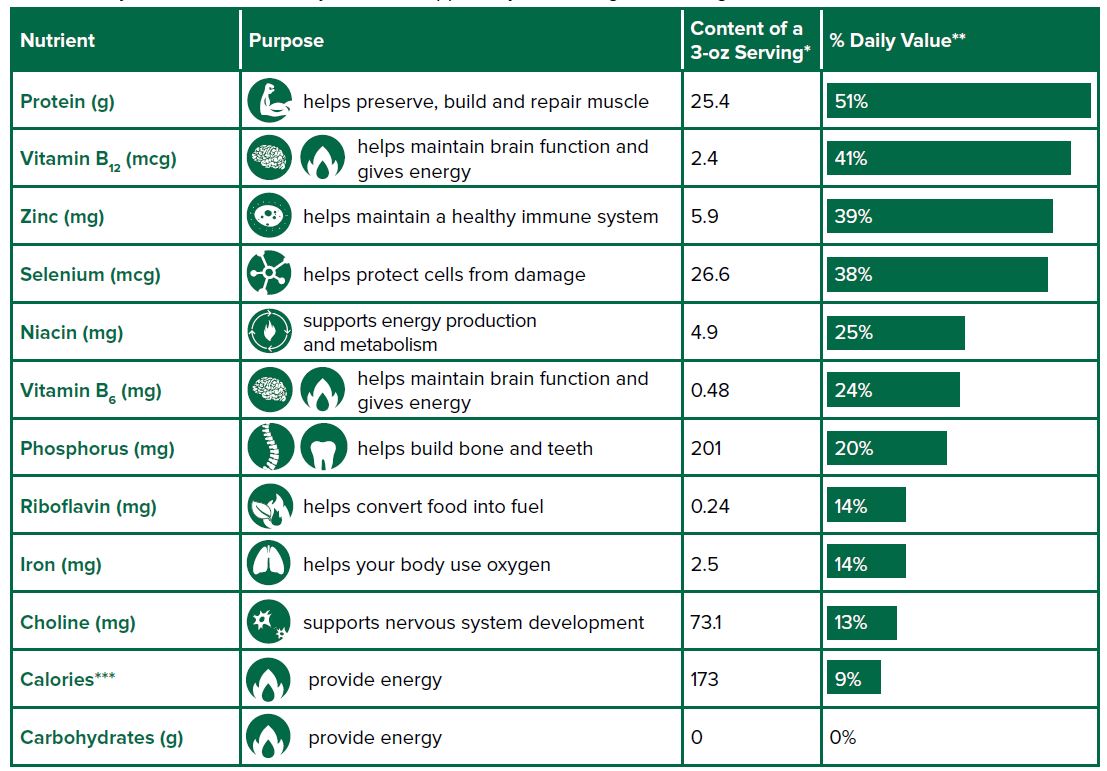Fact Sheet
Tough Questions About Beef Sustainability:
How Does Upcycling Relate to Beef Production?
E.M. Andreini | University of California, Davis
Regardless of popular trends and social media fads, cattle have been upcycling long before society adopted use of the term. Cattle upcycle low-quality human-inedible feeds, that some other animals or humans cannot consume (i.e., forages), and convert them into a high-quality, high-protein product in the form of beef (Fig. 1).

Figure 1. Cattle upcycle resources humans can’t use directly into desirable and high-quality protein, micronutrients and products, like leather.
In the US, 90% of the feed consumed throughout the lifetime of grain-fed cattle is human-inedible (NASEM, 2016), and cattle consume a number of different feeds that classify them as upcyclers. Inadequate for growing crops for human consumption, the 800 million acres of rangeland grazed by cattle comprise 35% of the United States (USDA ERS, 2018). Cattle consume by-products from the biofuel and food industries, such as distillers grains and wheat middlings, which are by-products of the ethanol production process and wheat flour milling process, respectively. Use of these by-products as cattle feed decreases the respective industry’s waste by providing an alternative use of the by-product compared to sending it to a landfill.
Cattle produce more than meat and contribute key by-products to society. Of the animal’s live weight, 42% is edible beef, and 44% produces numerous by-products (Marti et al., 2011). Cattle by-products are components of many items from leather to pharmaceuticals and cosmetics to pet food. Properly managed cattle grazing can improve rangelands and wildlife habitats, which are some of the ecosystem services cattle provide.
Additionally, beef in the diet provides essential micronutrients (e.g., Niacin, Vitamin B-12, riboflavin, iron and zinc; Table 1) that can be difficult to obtain in adequate quantities from plant food sources alone. Animal proteins have a higher value than plant-based proteins in human diets due to higher digestibility and superior amino acid compositions (CAST, 1999). Protein quality is an important aspect to consider when comparing plant and animal-based dietary sources, and animal proteins often offer twice the value of edible plant-based proteins in human diets (Ertl et al., 2016). Animal products in human diets provide an important source of energy and protein and have been shown to improve growth and development in children (CAST, 1999).
Ruminants serve a valuable role in the conversion of feeds grown on non-arable lands into human-edible protein and by-products into products suitable for human consumption (Oltjen and Beckett, 1996). Utilizing cattle and their upcycling capabilities provides benefits to society, the land and the sustainable production of livestock.
Bottom Line: Cattle consume low-quality human-inedible feeds other animals or humans cannot and convert them into a high-quality, high-protein product in the form of beef. Beef also provides essential micronutrients and other key by-products to society. Cattle have been upcycling long before it was trending on social media.
Table 1.Daily recommended dietary nutrients supplied by consuming one serving of beef

*Nutrient content of a 3 oz serving of beef is based on the Reference Amount Customarily Consumed (RACC) of beef established by USDA. USDA National Nutrient Database for Standard Reference, NDB# 13364. **DV refers to Daily Value, the amount of a nutrient needed for a healthy adult on a 2,000-calorie diet. The %DV is the percent of a nutrient’s DV supplied by a particular food. ***Percent of calories is based on a 2000-calorie daily diet.
References
- Code of Federal Regulations, Subpart B, Nutrition Labeling, Section 9 CFR 317.312 - Reference amounts customarily consumed per eating occasion. 2011.
- Council for Agricultural Science and Technology (CAST). 1999. Animal agriculture and global food supply. Task Force Report no. 135, July 1999. CAST, Ames, IA, USA.
- Ertl, P., W. Knaus and W. Zollitsch. 2016. An approach to including protein quality when assessing the net contribution of livestock to human food supply. Anim. 10:1883-1889.
- Food and Drug Administration (FDA). 2016. Food labeling: revision of the nutrition and supplement facts labels. Federal Register. 81(103):33982-33983. https://www.gpo.gov/fdsys/pkg/FR-2016-05-27/pdf/2016-11867.pdf
- Marti, D. L., R. J. Johnson, and K. H. Mathews, Jr. 2011. Where’s the (not) meat? Byproducts from beef and pork production. US Department of Agriculture Economic Research Service. LDP-M-209-01.
- National Academies of Sciences, Engineering, and Medicine. 2016. Nutrient Requirements of Beef Cattle: Eighth Revised Edition. Washington, DC: The National Academies Press. https://doi.org/10.17226/19014.
- Oltjen, J.W. and J.L. Beckett. 1996. Role of ruminant livestock in sustainable systems. J. Anim. Sci. 74:1406-1409. United States Department of Agriculture (USDA) Agricultural Research Service, Nutrient Data Laboratory. USDA National Nutrient Database for Standard Reference, Legacy. Version Current: April 2018, NDB #13364. Available at http://www.ars.usda.gov/ba/bhnrc/ndl
- USDA Economic Research Service (USDA-ERS). 2018. Major land uses. https://www.ers.usda.gov/data-products/major-land-uses/
- USDA, 2010. Nutrition Labeling of Single-Ingredient Products and Ground or Chopped Meat and Poultry Products; Final Rule. Federal Register, 75(249).